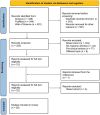The impact of PET imaging on triple negative breast cancer: an updated evidence-based perspective
- PMID: 39110196
- PMCID: PMC11599309
- DOI: 10.1007/s00259-024-06866-9
The impact of PET imaging on triple negative breast cancer: an updated evidence-based perspective
Abstract
Introduction: Triple-negative breast cancer (TNBC) is a subtype of breast cancer characterized by the absence of estrogen, progesterone, and HER2 receptors. It predominantly affects younger women and is associated with a poor prognosis. This systematic review aims to evaluate the current role of positron emission tomography (PET) in the management of TNBC patients and to identify future research directions.
Methods: We systematically searched the PubMed, Scopus, and Web of Science databases up to February 2024. A team of five researchers conducted data extraction and analysis. The quality of the selected studies was assessed using a specific evaluation form.
Results: Twenty-eight studies involving 2870 TNBC patients were included in the review. Key clinical applications of PET in TNBC included predicting pathological complete response (pCR) in patients undergoing neoadjuvant chemotherapy (NAC), assessing the prognostic value of baseline PET, and initial disease staging. Two studies utilized PSMA-ligand agents, while the majority used [18F]FDG-based PET. Significant associations were found between baseline [18F]FDG uptake and molecular biomarkers such as PDL-1, androgen receptor, and Ki67. Baseline [18F]FDG PET led to the upstaging of patients from stage IIB to stage IV, influencing treatment decisions and survival outcomes. In the NAC setting, serial PET scans measuring changes in [18F]FDG uptake, indicated by maximum standardized uptake value (SUVmax), predicted pCR with varying cut-off values correlated with different response rates. Semiquantitative parameters such as metabolic tumor volume (MTV) and PET lung index were prognostic for metastatic disease.
Conclusions: In TNBC patients, [18F]FDG PET is essential for initial disease staging in both localized and metastatic settings. It is also useful for assessing treatment response to NAC. The ability of PET to correlate metabolic activity with molecular markers and predict treatment outcomes highlights its potential in TNBC management. Further prospective studies are needed to refine these clinical indications and establish its definitive role.
Keywords: Molecular imaging; PET/CT; Prostate specific membrane antigen; Radiomics; Theranostics; Triple negative breast cancer.
© 2024. The Author(s).
Conflict of interest statement
Declarations. Ethic approval: Not applicable. Consent for publication: Not applicable. Conflict of interest: the authors declare that they have no competing interests.
Figures



References
-
- Global Cancer Observatory. https://gco.iarc.fr/en. Accessed 30 May 2024.
-
- Foulkes WD, Smith IE, Reis-Filho JS. Triple-negative breast Cancer. N Engl J Med. 2010;363:1938–48. - PubMed
-
- Li X, Yang J, Peng L, Sahin AA, Huo L, Ward KC, et al. Triple-negative breast cancer has worse overall survival and cause-specific survival than non-triple-negative breast cancer. Breast Cancer Res Treat. 2017;161:279–87. - PubMed
Publication types
MeSH terms
LinkOut - more resources
Full Text Sources
Research Materials
Miscellaneous

